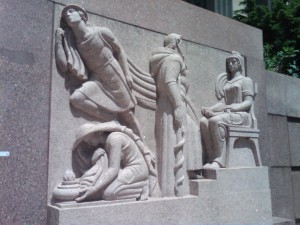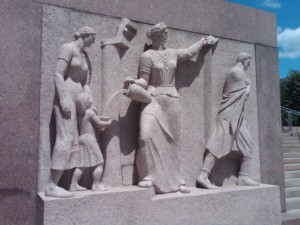And Some Relief
You’ve all been there – doing anything you can to avoid a lenghty conference call at the office. Yesterday, in lieu of a status hearing on the MPD Motions to Quash detectives’ deposition testimony based on law enforcement privilege, a conference call was all that occurred.
 At issue was was the MPD’s hesitancy, argued by the DC AG’s office, to have their detectives open up the Wone murder case files, for fear that it could jeopardize their further efforts and violate the sanctity of the investigative process.
At issue was was the MPD’s hesitancy, argued by the DC AG’s office, to have their detectives open up the Wone murder case files, for fear that it could jeopardize their further efforts and violate the sanctity of the investigative process.
Judge Michael Rankin, did however rule, and issued an order later in the day to try and settle the dispute. About fifteen minutes before the 1:45pm scheduled start, the court clerk told observers that the conference call option was a distinct possibility.
The next clue that there wasn’t going to be a hearing was the surprising lack of attorneys that normally haunt the hallway to courtroom 517, and inside the room itself.
One however did show up but he wasn’t attached to these particular proceedings. Assistant US Attorney Glenn Kirschner, lead prosecutor for last summer’s conspiracy and obstruction trial, and for all we know, starting quarterback once again if there is ever a murder trial, did a drop by.
The media attendance in 517 seemed to outweigh the relatively minor, procedural issue at stake yesterday, but Legal Time’s Mike Scarcella, The Post’s Keith Alexander and the Examiner’s Emily Babay were on hand.
 Several members of the Wone family took seats in the back row of 517 and waited patiently for word on whether there’d be a hearing.
Several members of the Wone family took seats in the back row of 517 and waited patiently for word on whether there’d be a hearing.
Mr. Kirchner came into the courtroom, took a seat in a row in front of them, and spoke discretely with them for about 10 minutes.
After about a half hour of waiting, word came down that the call had happened and that Rankin would rule on the matter (below); he split the difference, or punted to a date to be determined.
“ORDERED, that both of the MPD’s Motions to Quash are DENIED WITHOUT PREJUDICE, as to MPD’s reassertion of the privilege in a timely fashion during the depositions in question. The court will rule at a future hearing, to be scheduled, on all questions that are not answered due to the assertion of the privilege during those depositions.”
Plenty remains on Judge Rankin’s plate, specifically the 5th Amendment fight. We’ve no indication on what his plans are to rule on that or when the next status hearing will be scheduled.
Bonus Round: Extra credit given to whoever can identify the artist(s) who did these relief sculptures that flank the steps on the courtyard next to Moultrie. Partial credit given to whoever can decipher the allegory. We’re guessing something along the lines of “The Wheels of Justice turn slowly (or sometimes grind to a halt completely).”

I’ve read and reread, Craig’s posting and the Judge’s ruling but don’t understand what’s going on. As I understand it, the asst AG, representing the police, and the defendants’ attorneys narrowed the list of the questions (to be asked of MPD witnesses) in dispute. But presumably were left with some number on which they could not agree as to their possibly compromising the criminal case. After that, I don’t get the subtleties as to the Judge’s ruling. Did he just certify that, by the parties having narrowed the questions themselves, there was no need to have a blanket quashing? Or did he rule something more substantive?
Craig: What was the “splitting the difference”?
All: Does “in a timely fashion” mean anything or just verbiage?
In other words, I’m lost. HELP!!
My reading of this has the depos proceeding and if there are questions MPD objects to, they blow them off and then go before Rankin to rule on whether they have to answer. I could be a mile wide.
But how does that move anything, even a mini step forward? It seems like a circular argument (or supreme procrastination on the judge’s part). So, in the deposition, the defense attorneys will ask police personnel the very questions that the MPD (still) objects to and wants to quash. The police witnesses will be instructed not to answer them. And then what? The parties come right back to the judge. How has the judge’s ruling made any progress?
I’m with Gloria on this. I don’t really see this judge as moving anything forward in this case thus far. His attitude appears to be, “Work it out amongst yourselves.” This appears to have worked (to some extent) with respect to the issue of the defendants versus the MPD. But the key issue before the court is the fact that the defendants have invoked their fifth amendment rights several hundred times (so far). I haven’t seen anything thus far to indicate that he’s doing anything to “move forward” with respect to this issue. And I see no indication that the plaintiffs or the defense are going to budge on their positions. I really don’t see this judge doing much to address this. I’ll grant you that there may be quite a bit of movement behind closed doors, but thus far, I’m thoroughly unimpressed with this judge.
Michael R., how could you!
This is really S.O.P. in civil cases — to let the deposition go forward to the extent it can without being held up by areas of disagreement. Nothing unusual here.
So, let me get this straight: The defendants got what they wanted but somehow “split the difference.” I guess that’s one way to subjectively view things. [Redacted]
I am sure that whatever that was it sounded better in the original German [with apologies to Molly Ivins].
Depos can go ahead but the MPD had the right to object to questions and have the judge rule on whether they have to answer. What is it about ‘split the difference’ that doesn’t translate well into German, Dieter?
And keep our day jobs out of this. This is your first and only warning.
I love the bonus rounds. I can’t find any corroborating evidence, but I did find the following in a National Register of Historic Places document:
“A terraced, grass-filled space is located in between the Moultrie Courthouse and the Municipal Center to its east. As part of the creation of the Municipal Center in 1940, sculptor Lee Lawrie designed a relief sculpture with figures symbolizing Light, Water and Thoroughfare. Due to problems with the stone for this relief, it was stored until the 1970s. When the Moultrie Courthouse was constructed, Lawrie’s relief was incorporated into the terrace retaining wall at the building’s east approach.”
How sad that the sculptures were stored for so many years. He died (1963) before it was ever used. Lawrie was one of this nations’ foremost architectural sculptors. He was responsible for much of the wonderful Art Deco work that can be seen at Rockefeller Center.
Thoroughfare?
Ok, then.
John Gregory. The sculpture is called “Urban Life”
Here’s something I found on the internet:
Relief depicting four allegorical figures representing four institutions of urban life: courts, hospitals, business, and sanitation. On the far right side of the relief is a female seated in a chair. She is dressed in loose drapery and a hat, her long, curly hair visible below. She is Maia, mother of Mercury, and she represents the institution of courts.
A male figure stands before her dressed in long drapery with a hood in the back. He has a beard and his proper left hand reaches up toward his chin. Under his proper right arm is a crutch with a snake wrapped around it. He is Aesculapius, the god of healing, and he represents the institution of hospitals. Flying off behind him, facing the in the opposite direction, is a figure of Mercury dressed is his customary winged cap. His cape flows out behind him and he looks off to the distance.
Mercury represents the institution of commerce and business. Below Mercury is a kneeling female figure hunched over with a cape over her head. Her proper left hand reaches forward toward a pot with a flame inside. She is Vesta, goddess of the hearth, and she represents the institution of the sanitation department.
The top one is John Gregory….
Thanks, Editors, for drawing attention to the references and uses of classical antiquity that still grace our lives. Yet, aren’t there more than four stations of urban life — where are Aphrodite and Dionysus, for instance?
Urban Life, John Gregory.
Agree with Hoya; forcing opposing counsel to proceed with discovery, agreeing or disagreeing wherever they need to to protect their clients rights and returning to the judge for ruling wherever agreement cannot be reached. What counsel agree upon cannot be reversible error; thus the judge plays it safe to the extent possible, exposing himself to error only were he can’t avoid it. Discovery is designed to save judicial time and resources and is ordinarily conducted out of the courtroom, out of the judge’s presence.